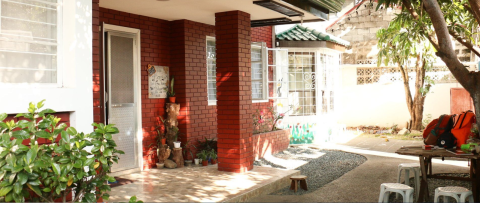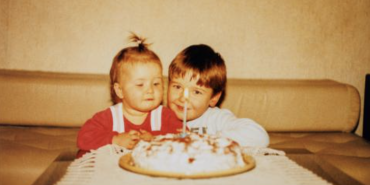Creating a Home: A Center in the Philippines Cares for Child Survivors of Exploitation

For You have been a shelter for me, A strong tower from the enemy.
Beyond a sliding metal gate is a basketball court, converted from its former life as a driveway. Past the basketball hoops is a new play structure, and to the right of both is a two-story brick house surrounded by brightly painted walls. Joshua,* 18, helped paint a horse on one of the walls, and Daniel, 14, painted a school of orange fish. The other children who are staying at the house chose the characters and scenes: a panda bear, characters from popular cartoons, and mountains.
Here, at the Shechem Children’s Home in the Philippines, children play on the basketball court and within the murals. Were you to stand on the other side of the metal gate on any given day, you would hear the shouts of laughter, the tallying of skips while jumping rope, and the swish of a ball going through the net. In short, you would hear the sounds of play—of children.
Providing space for children to be children again is integral to the home's mission because their childhood innocence was taken away from them. The Philippines is a global hub for the online sexual exploitation of children (OSEC). Of the 12 children who live at the Shechem Children’s Home, 11 are survivors of exploitation.
WHAT IS OSEC?
OSEC isn’t the same as other forms of human trafficking, so it can’t be addressed the same way. While labor trafficking and sex trafficking involve abuse in-person, OSEC is capturing sexual abuse on digital media, typically video but sometimes photos as well. The videos are livestreamed and directed by those paying to watch. And those paying to watch are usually men in Western countries: The United States, Australia, Germany, and the United Kingdom. Leody Tan Echavez III, NCM Coordinator for the Church of the Nazarene in the Philippines, says this is part of what makes OSEC so insidious.
“[With] traditional sex trafficking you just need to go to a brothel or a red-light district and it's there, but in OSEC it is happening everywhere,” Echavez says.
Hannah and Christie were exploited for years before coming to Shechem. The perpetrator was someone in the community who groomed a friend of theirs. That child was taught to invite her friends over to play, but the exploitation of the girls is not her fault. She, too, was used by both the man who sold them and the people who paid. When their grandmother discovered what was going on, she was horrified and acted immediately.
Typically, but not always, the abuse doesn’t involve an adult touching a child. Instead, it’s the adult directing children to perform acts. This leads to the distressingly common narrative that OSEC doesn’t impact children when there isn’t any touching between them and the adults involved. Often—an estimated two-thirds of the time—the main perpetrators of OSEC are the child’s parent or a direct relative. Many parents, believing that abuse has to involve touching, don’t see such acts as bad. Children, wanting to please their parents and help their families, don’t realize it’s wrong.
FAMILY INVOLVEMENT
Daniel, 14, came to Shechem with his sister Angela, 16, their friend Jasmine, 18, and her one-year-old daughter, Bea. Jasmine’s mother-in-law was the perpetrator of their exploitation. Now, Jasmine is learning what it means to be a teenage mother with the support of the staff at Shechem rather than her family.
The crime itself is relatively new. The first case of livestreamed exploitation of children in the Philippines was reported in 2011, and the prevalence has been growing rapidly since. In the last five years, reports of suspected online sexual abuse of children have skyrocketed from a little more than 100,000 to 18 million globally. Children in reported cases range in age from infancy to 18 years. If Jasmine hadn’t been rescued when she was, it’s likely that Bea would have ended up exploited as well.
Many young children believe it’s their fault when their parent or aunt or uncle ends up in jail. Echavez says much grooming goes into the process of gaining children’s trust with the intention of exploiting them. Often, the children don’t see themselves as victims, and they struggle to wade through the reality of what has happened to them.
“They don't want to lose these people,” Echavez says. “They want to keep these people, so they prefer to have bad parents. … because they prefer to have a bad family than [no] family at all.”
LIFE AT THE HOME
Shechem Children’s Home, which is supported through Nazarene Compassionate Ministries, is the first of its kind in the Philippines. After being rescued, children receive medical exams and police reports are filed. Then they go to a long-term shelter, where male and female siblings are separated, and there isn’t always one-on-one assessment to determine what the next best step is for the child. At Shechem, however, children regularly meet with the social worker and therapist for individual and group therapy. They participate in weekly devotionals led by church volunteers, and sometimes the house hosts other classes like jiu jitsu or art.
Hannah and Christie are at Shechem so that they can receive therapy from contracted therapists as well as support from the social worker; eventually, once it is safe, they will go back to live with their family. They are joined by 10 other children ranging in ages from one to 18 years. They come to Shechem through the International Justice Mission, one of several organizations that partners with the church. Most of them are still in school, so they work with tutors at the house to make sure they aren’t falling behind in their schoolwork.
Safety, both real and perceived, is crucial at Shechem. Because the sisters feel safe, they are building relationships. When asked what they wanted to be when they grow up, the sisters both said policewomen first.
Most children have dreams like these. But thoughts of the future are interrupted, if not completely shattered, by traumatic events.
THE IMPACT OF TRAUMA
Because so many of the perpetrators are family members, a constant concern is where children will live after they are rescued. Daniel, Angela, Jasmine, and Bea can’t return to their homes; the risk of further exploitation is too great. Whatever the circumstances, being removed from their families is trauma in and of itself. Safety from both further exploitation and re-traumatization are crucial.
Children have three options for long-term reintegration following their rescue: living with a non-offending family member in a safe environment, foster care, or a long-term shelter. Shechem is the intermediary between rescue and that final decision. While they want to provide a safe space for the children to feel comfortable, they also want to make the assessment fast so children can begin to thrive where they are placed long-term.
Since the children who stay at Shechem don’t always realize they’ve been the victims of exploitation, part of the house social worker’s jobs is helping children process that fact. Neil Braga, one of the family social workers, has a different role than those at the house; his job is to figure out what Shechem can do to help parents or other nonoffending family members. The separation can be traumatic on all sides. Recently, with the help of one of the partner organizations working with the church, they hosted a family day at a water park with non-offending relatives.
A CATALYST OF CHANGE
The scope of OSEC is so large that it seems nearly impossible not to become overwhelmed. Instead of feeling immobilized, though, members of the Church of the Nazarene felt called to respond when they learned about OSEC. The Shechem Home was born out of that call. Stephen Gualberto, field strategy coordinator for the Church of the Nazarene in the Philippines and Micronesia, says that the church can be a rallying point to combat exploitation.
One staff member says that she sees her job as giving time, attention, and respect. But, along with the others at the house, she also acknowledges that God is the one who transforms. They can provide the therapy, case work, tutoring, devotionals, and safety for the children to thrive. But only God’s love can restore.
It would be an error to believe that all of the trauma, complicated emotions toward family members, and pain can be erased in the few months that children spend at Shechem. It is not so simple. Abuse is something that survivors grapple with for the rest of their lives.
The Shechem Children’s Home isn’t ignoring these long-term implications. Rather, they’re just trying to provide the space and tools for the children and their families to begin the process of ongoing healing in the months and years ahead. It’s clear that the children at Shechem feel comfortable there. Despite the context, the CCTV security cameras, and guards, the Shechem Children’s Home is indeed a home.
The hope is that by the end of their time at Shechem, each child will be able to reclaim a little of their childhood again.
“That is our goal—that [Shechem] would not become a facility or institution for them, but it would be a safe space for them to just be a kid,” Echavez says.
To support the Shechem Children’s Home, visit NCM.org/ShechemHome
*Children’s names are changed for protection.
This version appeared in the May/June 2021 issue. It is an abbreviated version of an article originally published in NCM Magazine, 2019 Issue 2. To read the full article in context, visit www.ncm.org/2019-issue-2




